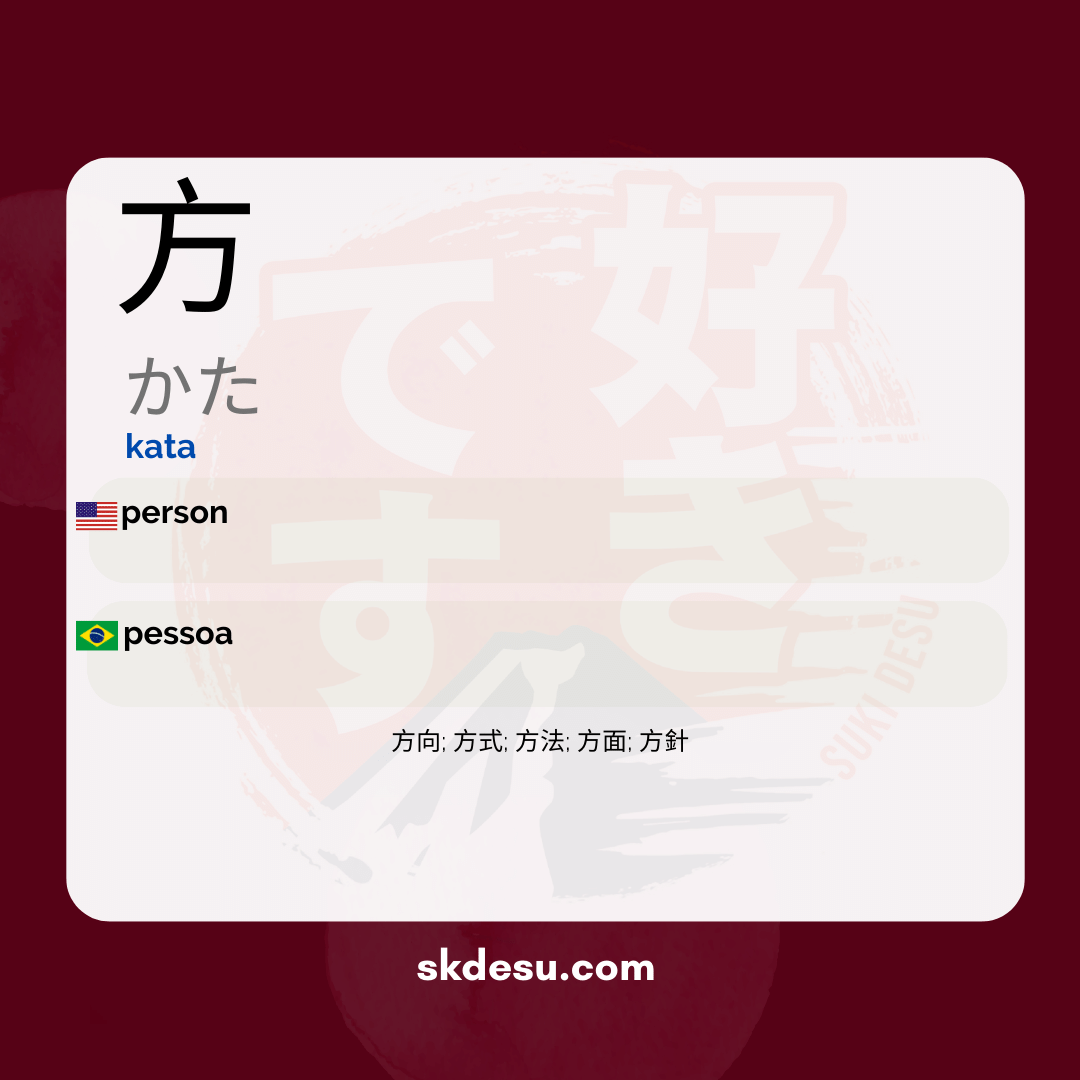Translation and Meaning of: 方 - kata
The Japanese word 方[かた] is a versatile and essential term for those learning the language. Its meaning can vary depending on the context, but it is generally related to direction, manner, or person. In this article, we will explore the usage of this word in everyday life, its origin, and how it is perceived in Japanese culture. If you want to understand better how 方[かた] functions in sentences or want to memorize it efficiently, keep reading!
Meaning and common uses of 方 [かた]
方 [かた] can be translated in different ways, depending on the situation. One of the most common meanings is "direction" or "side," as in こっちの方 (kocchi no kata) – "to this side." It can also indicate a person in a respectful manner, replacing 人 (hito) in formal contexts, as in この方 (kono kata) – "this person."
Additionally, 方 appears in expressions that describe ways of doing something, such as やり方 (yarikata) – "way of doing". This flexibility makes the word useful in various situations, from casual conversations to more formal language.
Origin and writing in kanji
The kanji 方 is composed of the radical 方 (direction) and has ancient origins in Chinese writing. It carries the idea of spatial orientation, which explains its use in words related to directions and methods. The pronunciation かた (kata) is one of the kun'yomi readings, while the most common on'yomi is ほう (hou), as in 方法 (houhou) – "method".
It is worth noting that, although the kanji is the same, the reading changes according to the context. This can confuse beginners, but with practice, it becomes easier to distinguish when to use かた or ほう. One tip is to observe if the word refers to a person (generally かた) or to a more abstract concept (such as in 方針 – houshin, "policy").
Tips for memorizing and using correctly
An effective way to remember 方[かた] is to associate it with concrete situations. For example, remembering that in restaurants or stores, employees might say こちら方へどうぞ (kochira kata e douzo) – "please, this way." This type of expression helps to memorize not only the meaning but also the natural pronunciation.
Another strategy is to practice with compound words that use 方, such as 話し方 (hanashikata - "way of speaking") or 読み方 (yomikata - "way of reading"). These terms are common in everyday life and reinforce the understanding of the grammatical structure in which 方 appears.
Vocabulary
Expand your vocabulary with related words:
Synonyms and similar words
- 方向 (Hōkō) - Direction, course
- 方式 (Hōshiki) - Method, a way of doing something
- 方法 (Hōhō) - Method, way to perform a task
- 方面 (Hōmen) - Area, field of consideration or perspective
- 方針 (Hōshin) - Guideline, action plan
Romaji: kata
Kana: かた
Type: noun
L: jlpt-n3
Translation / Meaning: person
Meaning in English: person
Definition: 【law】 1. A method or way of perceiving or thinking about things.
Quick Access
- Vocabulary
- Writing
- Sentences
How to Write in Japanese - (方) kata
See below a step-by-step guide on how to write the word by hand in Japanese. (方) kata:
Example Sentences - (方) kata
See below some example sentences:
Kankou wa Nihon no bunka o taiken suru subarashii houhou desu
Tourism is a great way to experience Japanese culture.
- 観光 - Tourism
- は - Topic particle
- 日本 - Japan
- の - Possessive particle
- 文化 - culture
- を - direct object particle
- 体験する - to experiment
- 素晴らしい - amazing
- 方法 - method
- です - be (linking verb)
Other Words of this Type: noun
See other words from our dictionary that are also: noun

